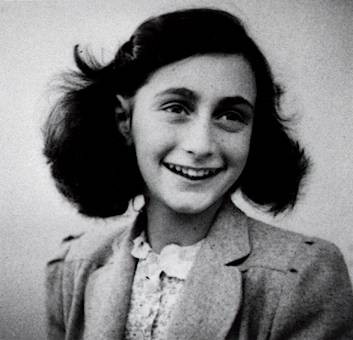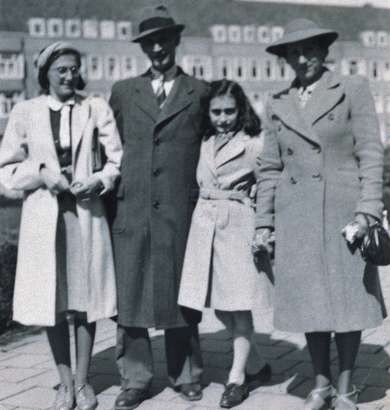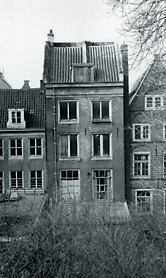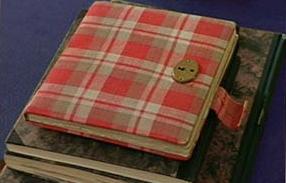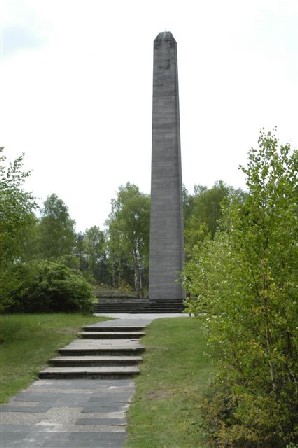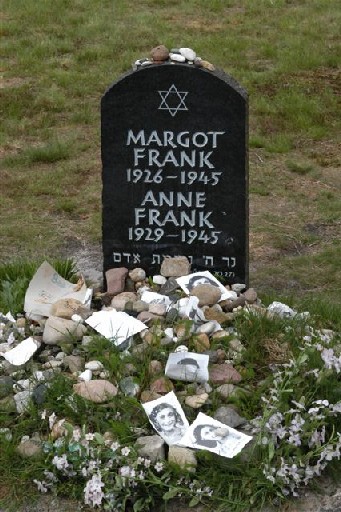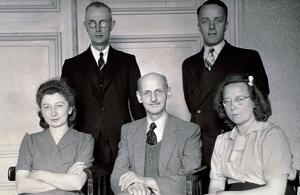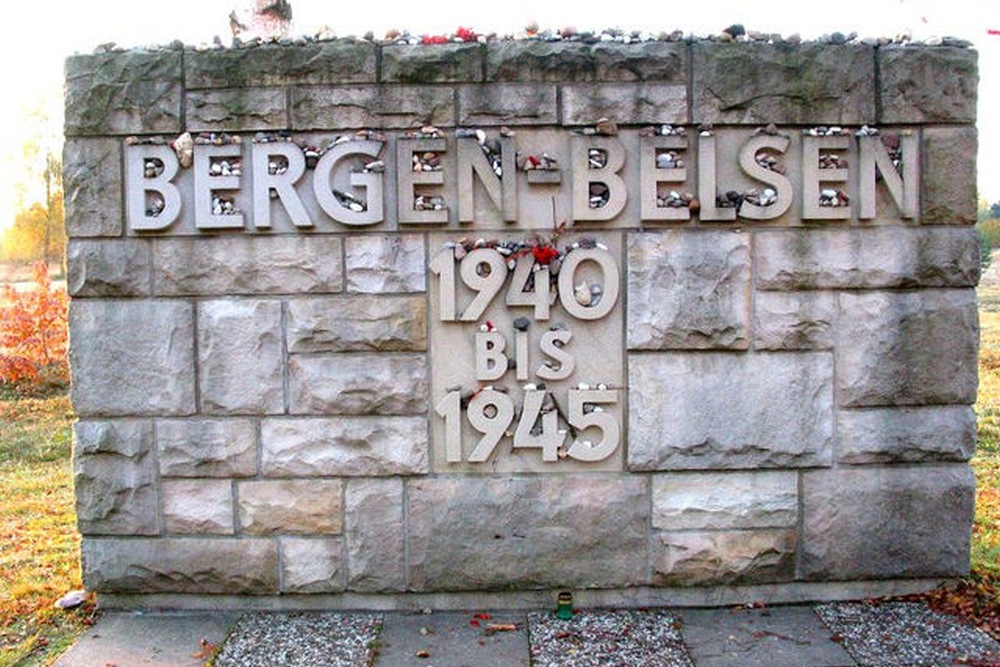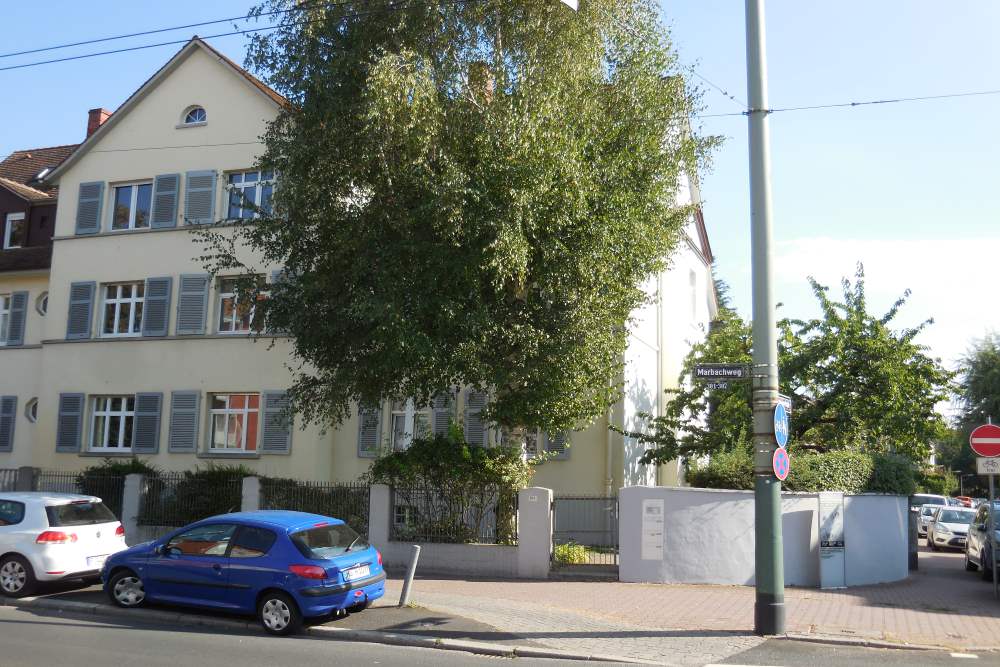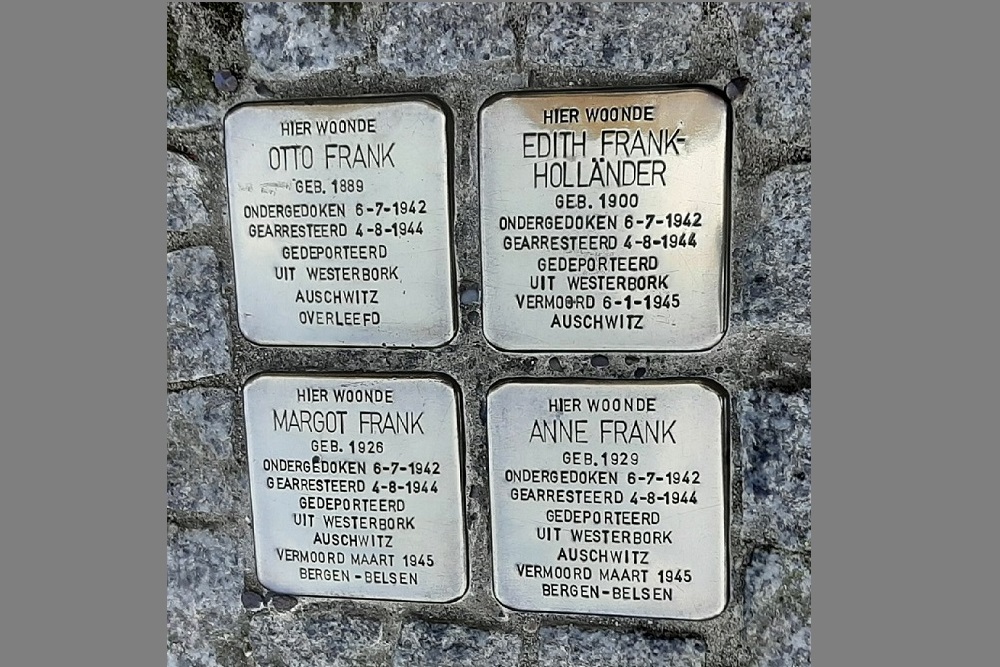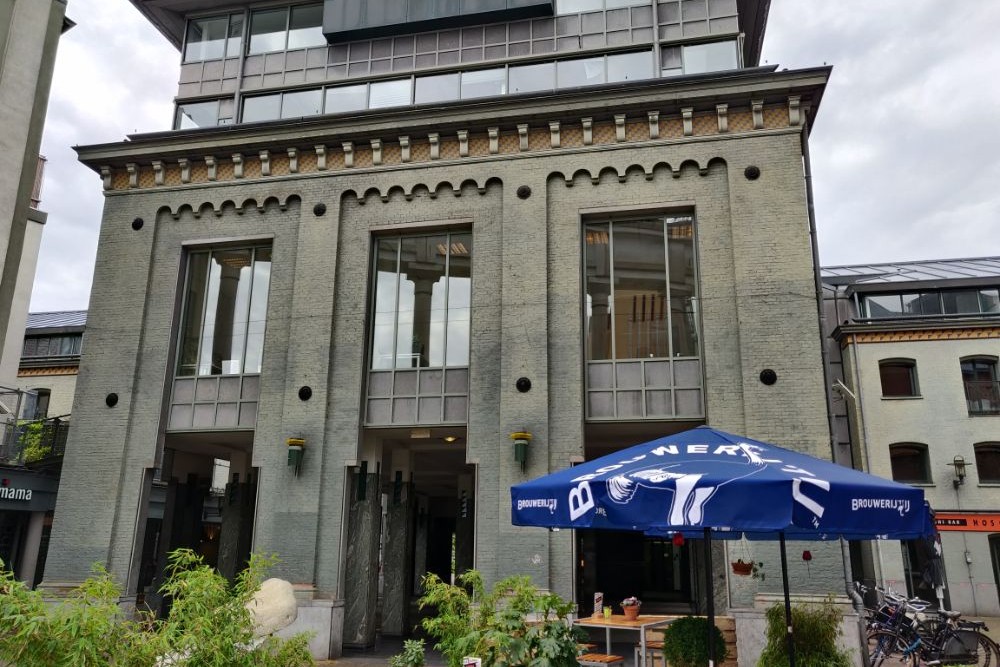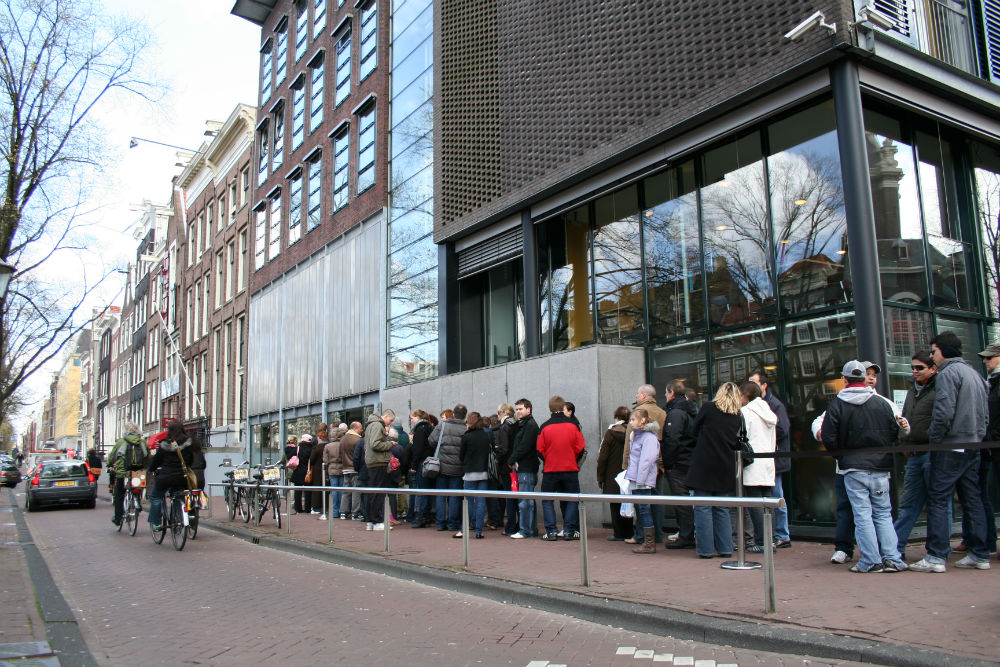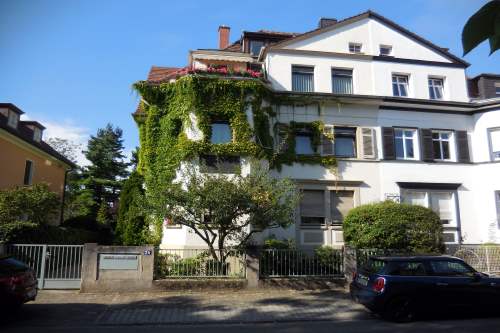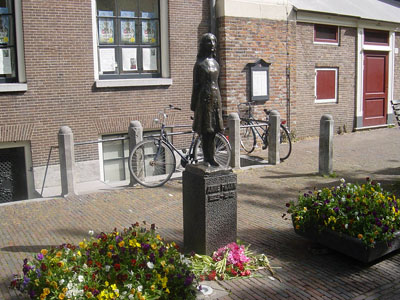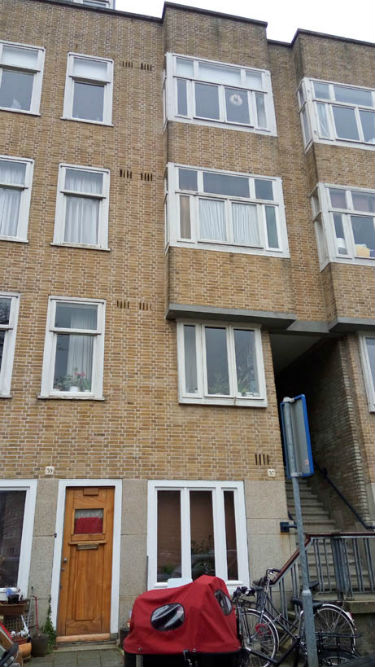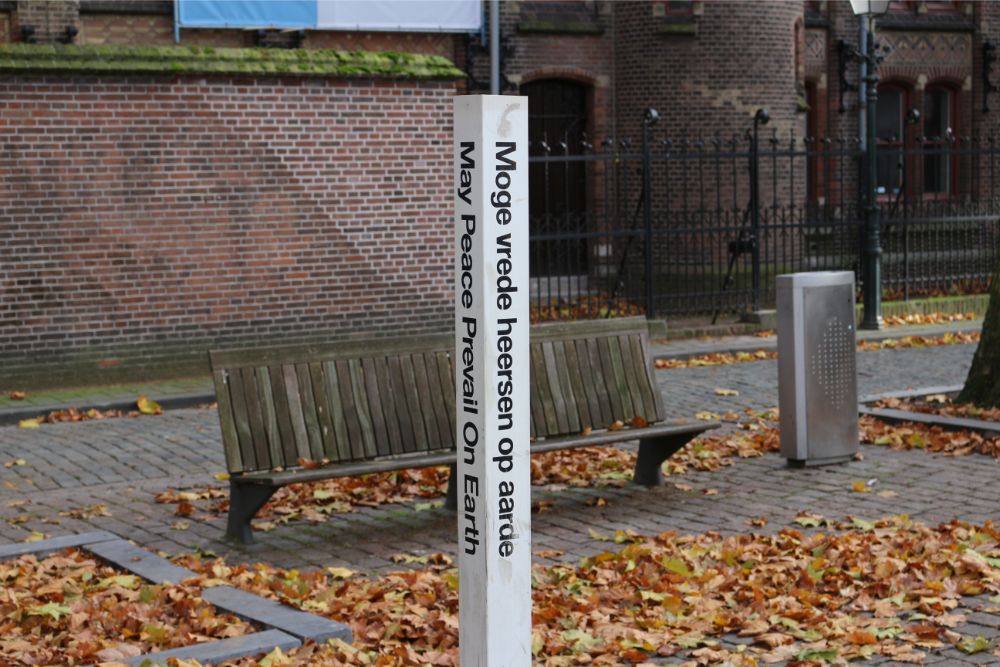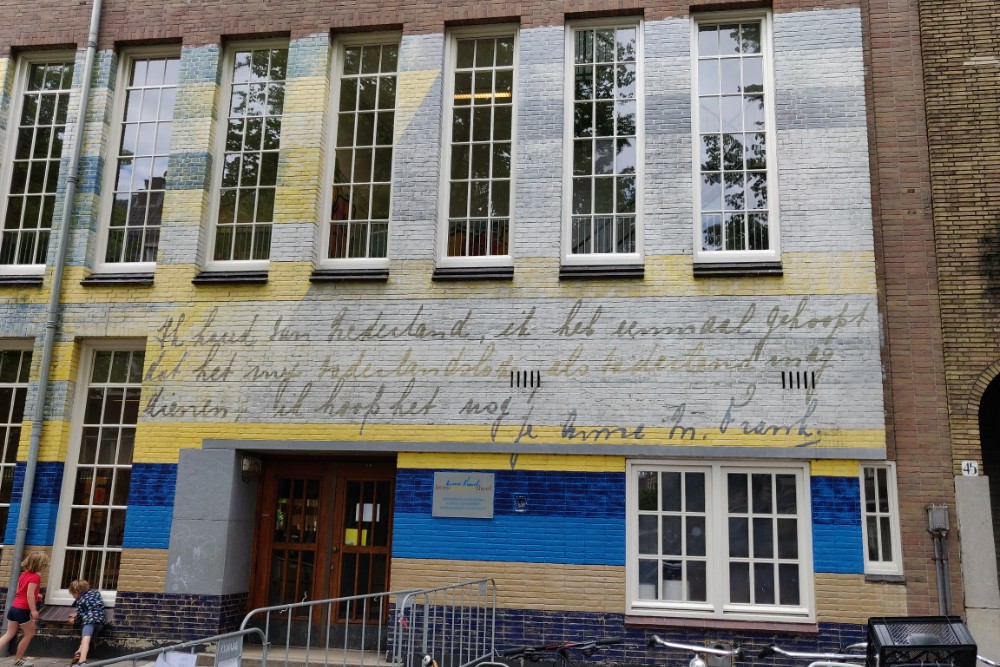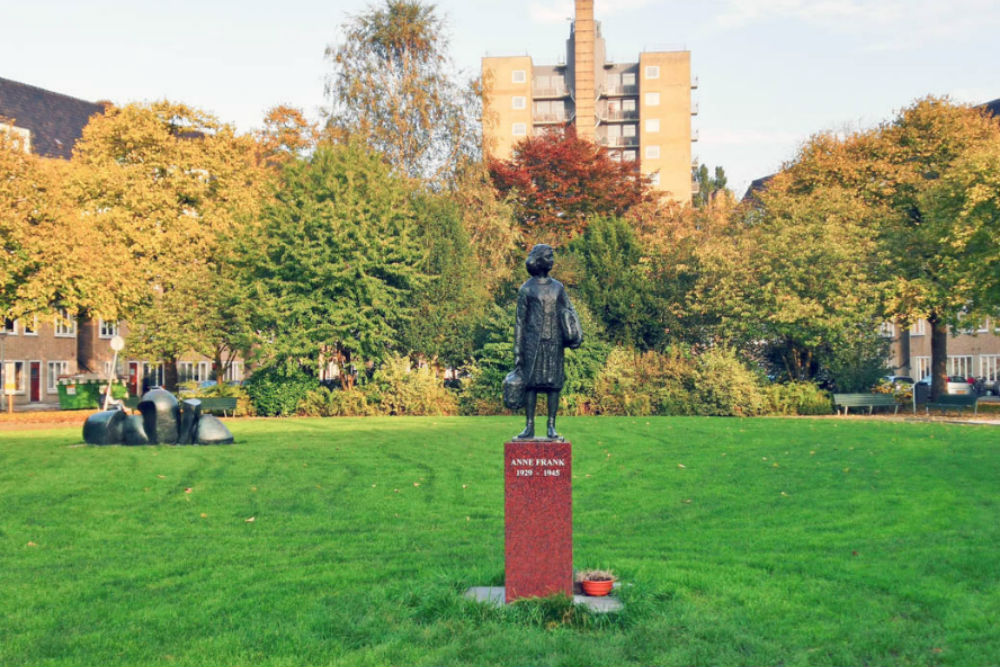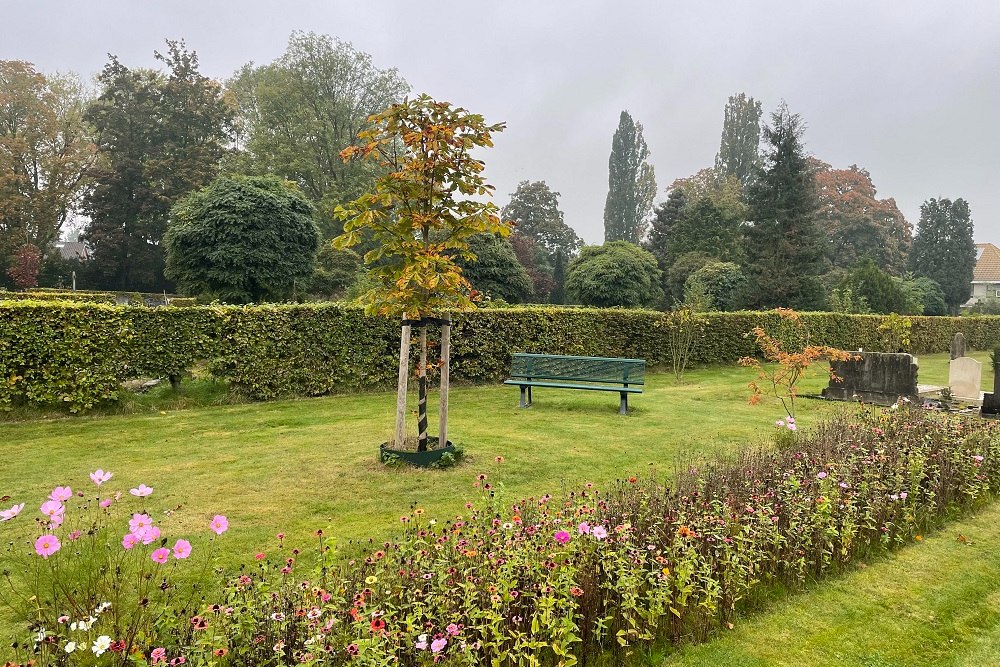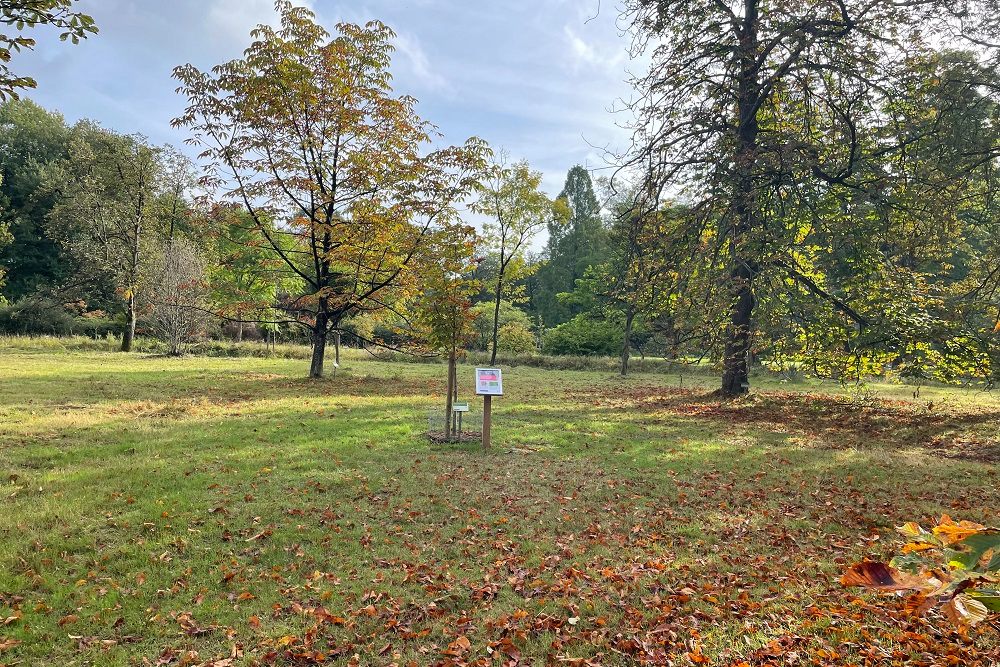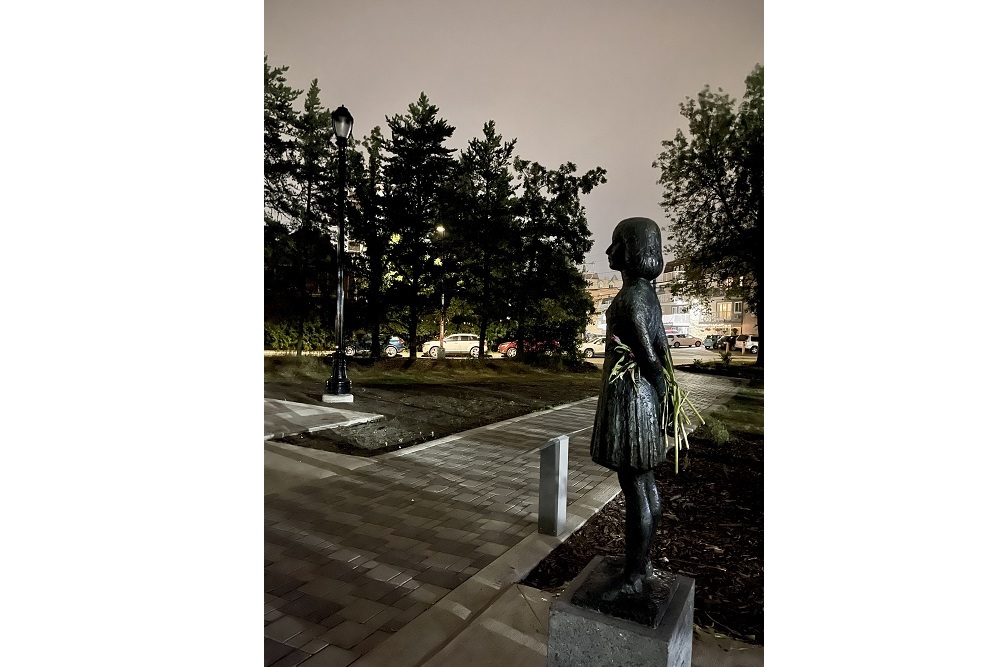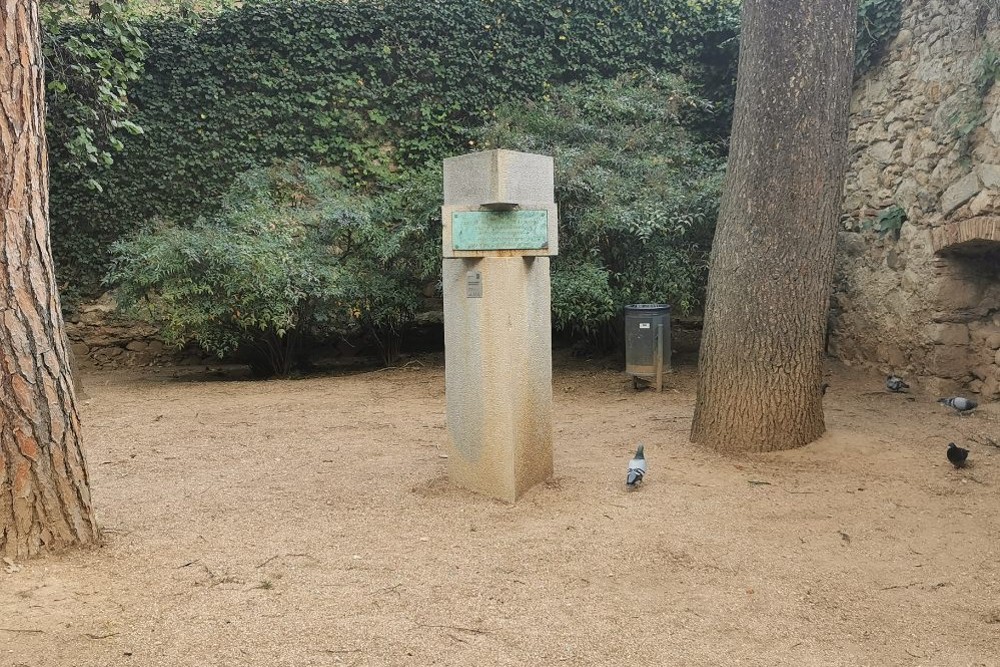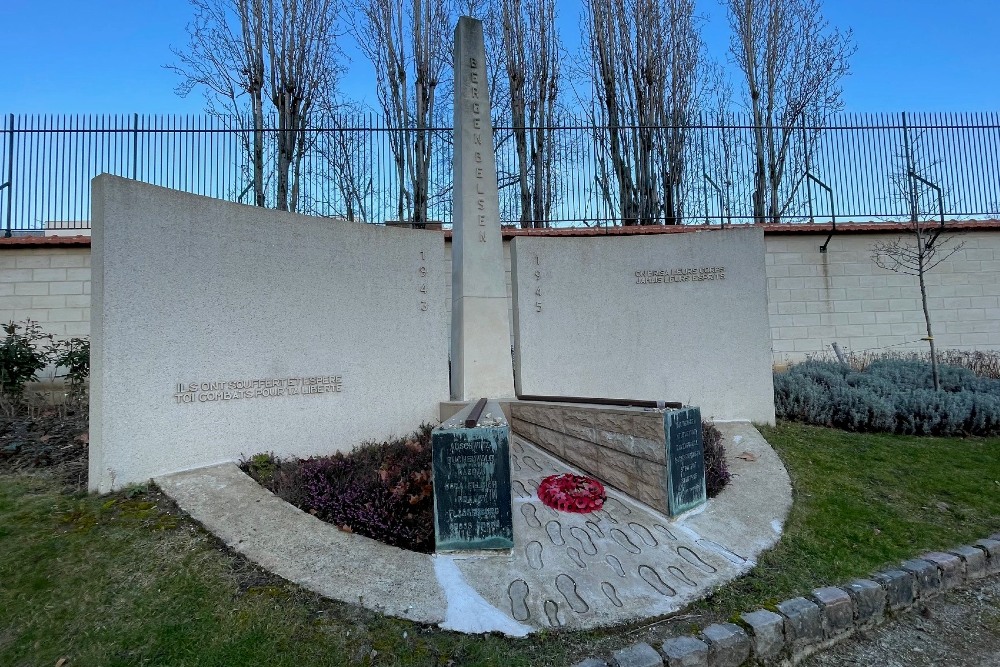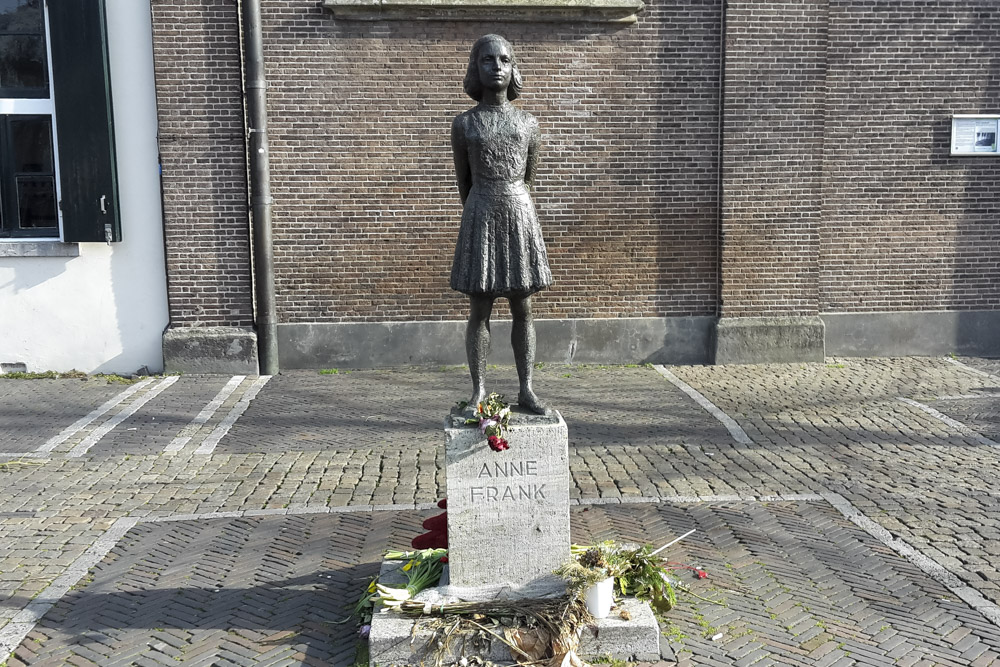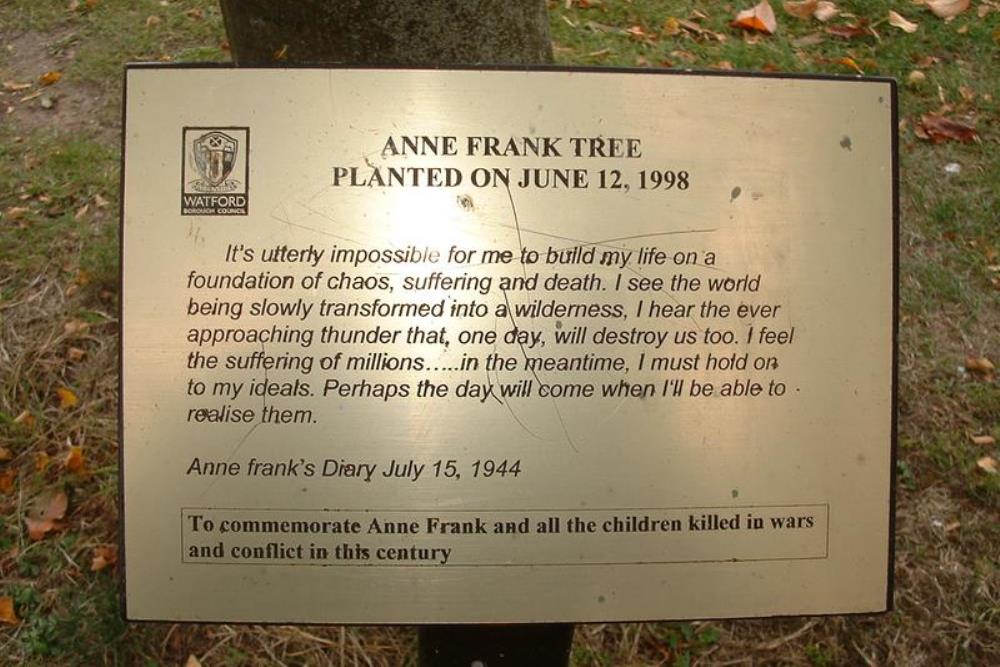Anne Frank, Icon of the Jewish persecution
Introduction
I hope I will be able to confide everything to you, as I have never been able to with anybody, and I hope you will be a big support for me.
This is the first sentence that Anne Frank entrusted to her diary. This diary, with the title "Het Achterhuis" (the Back House), has been translated into more than sixty-five languages and has been read by tens of millions of people all around the world. Anne Frank kept her diary from June 12th, 1942 until August 1st, 1944. From the 6th of July 1942 on, she and her family went into hiding in a backroom of her father’s office on the Prinsengracht 263 in Amsterdam. They had to go into hiding for the German occupying powers, that deported Jewish inhabitants of the Netherlands to German extermination camps in Poland from the summer of 1942 on.
In her diary Anne writes about the period she spent in hiding in the back house and about the many frightening, distressed, amorous and rebellious moments she went through there. Anne’s diary is the world’s most known eyewitness account of the persecution of the Jews, and besides that it gives a glimpse into the world of experience and the train of thought of a girl in her puberty.
Anne died from typhus in the concentration camp Bergen-Belsen in February or March 1945. Her father, Otto Frank, made sure her diary was published. Anne Frank, a girl with her own look on life, became a worldwide symbol of the persecution of the Jews after her death. For many, the name Anne Frank is a synonym for the tragedy that happened to many millions of Jewish people during the years of World War II.
This article sketches an image of the life of Anne Frank. Although Anne Frank died in 1945, her memory lives on until this date. Even today Anne Frank and her diary play an important educative role. This article consequently describes in which way this commemoration became so world-renowned.
 Klik hier voor de Nederlandstalige versie van dit artikel.
Klik hier voor de Nederlandstalige versie van dit artikel.
Definitielijst
- concentration camp
- Closed camp where people are being held captive that are considered to be anti- social, enemies of the state, criminal or unwanted individuals. These groups mostly do not get a fair trial or are condemned to doing time in a camp.
- Jews
- Middle Eastern people with own religion that lived in Palestine. They distinguished themselves by their strong monotheism and the strict observance of the Law and tradition. During World War 2 the Jewish people were ruthlessly persecuted and annihilated by the German Nazis. . An estimated 6,000,000 Jews were exterminated.
- persecution of the Jews
- "Judenverfolgung", action imposed by the Nazis to make life hard for the Jews, to actively persecute them and even annihilate them.
Images
Anne's life in freedom
Emigration from Germany
Annelies Marie Frank was born in the German city of Frankfurt am Main on June 12th, 1929. Anne was the second daughter of Otto Frank and Edith Frank-Holländer. Her little sister, Margot, was three years old when Anne was born.
Anne’s father worked at his family’s bank and her mother was a housewife. Anne and Margot had a carefree childhood in Franfurt am Main, but during that time their parents had already started to fear Adolf Hitler and his party, the NSDAP. Hitler gained more and more supporters in the first three years of the 1930s. In his inciting speeches he claimed that the Jews had caused all of Germany’s economic and social problems. The Frank family was Jewish and even though the Frank and Holländer families had been living in Germany for ages, they felt less and less at ease in Germany.
When Hitler became German Chancellor on January 30th, 1933, many aspects of the daily lives of Jews in Germany changed. Jews were discriminated and many of them emigrated from Germany. The Frank family wished to emigrate as well, partly because Otto Frank’s bank had gotten in financial problems thanks to the worldwide economic crisis. In the summer of 1933, Otto Frank left for the Netherlands, the rest of the family moved there February 1944.
Otto Frank started a business in Amsterdam selling Opekta. Opekta was a gelling agent that made housewives able to make their own jam. The Frank family moved into a newly built house on the Merwedesquare. Anne and Margot went to school where they learned the Dutch language. Just like in their early youth they experienced good times. They did not suspect that this carefree life would soon come to an end.
World War II in the Netherlands
When Germany invaded Poland on September 1st, 1939, the Second World War started. The Netherlands took a neutral position in this war. The Frank family had nothing to be afraid of until the German army invaded the Netherlands on May 10th, 1940. The Dutch army soon had to surrender to the stronger German army. From May 15th, 1940 on, the Germans occupied The Netherlands.
For the Frank family, the nightmare started again. Just like in Germany, more and more discriminating measures were taken against the Jews. For instance, Jews were not allowed to have their own company, Jewish children had to attend Jewish schools, Jewish public servants were discharged, Jews did not have access to several public provisions and all Jews had to wear a yellow Star of David. More and more it was rumoured that Jews were obligated to go back to Germany to work in camps.
These rumours turned out to be true, on July 5th of 1942 Margot Frank received a summons to leave for Germany and work in a work camp there. If Margot refused to go, the Nazi’s threatened to arrest her whole family. However, the family was prepared for this summons and went into hiding, just like many other Jews.
Definitielijst
- Jews
- Middle Eastern people with own religion that lived in Palestine. They distinguished themselves by their strong monotheism and the strict observance of the Law and tradition. During World War 2 the Jewish people were ruthlessly persecuted and annihilated by the German Nazis. . An estimated 6,000,000 Jews were exterminated.
- Nazi
- Abbreviation of a national socialist.
Images
Hiding in the back house
Going into hiding
The Frank family had initially planned to voluntarily go into hiding on the 16th of July. However, the summons for Margot made sure the family decided to go into hiding sooner. On the 6th of July they moved to an empty part of Otto Frank’s company building on Prinsengracht 263. In the front part of this building work continued normally, but several backrooms had by then been transformed to a hidden living space where eight hiding persons eventually stayed. The entrance to this space was hidden behind a revolving bookcase. Anne described the space as ‘the back house’; this later became the title of her published diary.
The persons in hiding
First seven and later eight people lived in the back house on the Prinsengracht. The Frank family lived in two rooms on the first floor and the Van Pels family lived in two rooms on the second floor. The Van Pels family consisted of Hermann and Auguste and their son Peter. The room of the Van Pels couple also functioned as a shared living room and dinner room. Peter stayed in a small room that gave access to the attic. On this attic, everyone kept their food and this was also where Anne and Peter regularly had intimate conversations.
In November 1942, an eighth person in hiding moved in with the Frank and Van Pels families. This man was an acquaintance of both families, the dentist Fritz Pfeffer. Fritz Pfeffer shared a room with Anne and Margot and later moved to their parents’ room.
The people in hiding tried to live their own lives in the small rooms, but the lack of privacy regularly caused tensions. Apart from that constant feeling of fear of discovery prevailed in the back house, which made everyone more tense and irritated. The diverse characters of the inhabitants regularly collided and Anne’s behaviour often was paramount to fights. Fits of rage had to be prevented though, because everyone had to be mouse-still, especially when people were working in the warehouse.
The helpers
The persons in hiding were supported by four of Otto Frank’s employees: Miep Gies, Johannes Kleiman, Victor Kugler and Bep Voskuijl. The helpers provided food, clothes, books and other requirements. Apart from that, their visits provided the back house with some necessary diversion and sociability and they kept its inhabitants up with the latest news. The news usually wasn’t good, because Amsterdam suffered from regular raids in which many Jews were arrested. The Jews were deported to the east and soon rumours started that they were killed there.
Definitielijst
- Jews
- Middle Eastern people with own religion that lived in Palestine. They distinguished themselves by their strong monotheism and the strict observance of the Law and tradition. During World War 2 the Jewish people were ruthlessly persecuted and annihilated by the German Nazis. . An estimated 6,000,000 Jews were exterminated.
Images
Anne’s diary
Anne’s diary
On June 12th, 1942, Anne wrote her first entry in the diary she had received for her thirteenth birthday. In her diary she started writing about the subjects every thirteen-year-old girl writes about. Anne wrote her diary entries in epistolary form and she addressed them to an imaginary confidante, ‘Kitty’. During the first days, Anne wrote about her birthday, her school and her classmates, her friends and the school report she would soon receive. Anne also wrote about her flight from Germany to the Netherlands, the German occupation and several discriminating measures against the Jews in the Netherlands. Anne had already experienced a lot more than the average non-Jewish girl in the Netherlands.
On the 6th of July 1942, the Frank family went into hiding. Anne wrote her first diary entry in the back house on the 8th of July 1942. The first days in the back house she wrote about moving house, their new accommodation and her fellow residents. After a while, Anne entrusted more and more of her feelings of fear, anger, sadness and being in love to her diary. Anne openly wrote about the negative feelings she felt towards her mother, the fights with the other inhabitants and the love she felt for Peter. Apart from that she wrote about all of the frightening moments of fear in the back house. Just like the other persons in hiding Anne was often scared to be discovered and as a lively girl she had a hard time being quiet all the time. As a lover of nature, Anne also had a hard time dealing with never being allowed to go outside. In stead, Anne could only enjoy the view of the starry sky from the attic. Apart from that, the chestnut tree that she often described in her diary was the only bit of nature she could see.
Anne also used her diary as a means of self-reflection. In the first weeks, Anne mainly criticized others, but in the course of the period she was in hiding, she wrote more and more about her own personality and her positive and negative sides. Anne quickly transformed from a naïve young into a serious girl with a mature look on herself, her fellow human beings and the world. Anne contemplated her future and wished to become a writer. On April 5th 1944 she wrote about this in her diary:
No one who doesn’t write knows how nice writing is; I used to always regret not at all being able to draw, but now I am blissfully happy I can at least write. And if I don’t have the talent to write for newspapers or to write books, well, then I can still write for myself. But I want to make progress, I cannot imagine that I would have to live as a mother, Mistress van Daan* and all those women who do their jobs and will later be forgotten. I have to have something besides a husband and children, something I can devote myself to! Oh yes, I don’t want to have lived in vain, like most people. I want to be useful or entertaining for the people, that live around me and nevertheless don’t know me, I want to live on, even after my death!
* = (pseudonym for Auguste van Pels)
Anne mainly used her diary as an outlet for her emotions. During her puberty her mental development was slowed down to some degree due to the restrictions of the back house. Anne did not go to school, could not go out and meet boys and was frequently thrown on her own resources. Despite several discouraged moments Anne was not depressed. She kept entertaining hope for the liberation. On May 3rd 1944 she wrote in her diary about her gloomy moments and the hope for liberation:
II have often felt discouraged, but never desperate, I consider this hiding as a dangerous adventure that is romantic and interesting. I consider every hardship as an amusement in my diary. I happen to have planned to lead a different life than other girls and later a different life than ordinary housewives. Every day I feel my how my spirit is growing, how liberation is nearing, how beautiful nature is, how good the people in my vicinity are, how interesting and amusing this adventure is! Why would I be desperate?
Anne as an author
In the spring of 1944 the Dutch Minister of Education in expulsion, Gerrit Bolkestein, made an appeal on Radio Oranje. He asked the Dutch people to write about the sufferings of the Dutch under the German occupation. These events, diaries for instance, could be gathered after the war and be published. Anne heard this appeal and decided to transform her diary into a book. She started editing her diary entries. She changed several texts, omitted certain uninteresting texts and added interesting memories. At the same time she kept writing in her original diary.
Anne did not only keep her diary, she also wrote several short stories. She told these stories to her fellows in hiding. She also kept a ‘beautiful sentences book’. In this special manuscript she copied sentences that made an impression on her from the books she read.
Definitielijst
- Jews
- Middle Eastern people with own religion that lived in Palestine. They distinguished themselves by their strong monotheism and the strict observance of the Law and tradition. During World War 2 the Jewish people were ruthlessly persecuted and annihilated by the German Nazis. . An estimated 6,000,000 Jews were exterminated.
Images
The tragical death of Anne
The last day in the back house
On August 1st 1944 Anne wrote in her diary for the last time. This day, Anne wrote about the contradiction she noticed in her own personality. Others perceived her as a lively, bold and unaffected girl, but internally she felt like a sentimental, silent and serious girl. She liked herself more as the silent Anne than as Anne ‘the clown’. She wrote the following about this:
In the company of others, the sweet Anne has never, not even once appeared, but in solitude she predominates. I exactly know how I would want to be, how I actually am… inside, but unfortunately, I am only that for myself. And maybe, no, very certainly that is the reason why I call myself a happy inner nature and others think of me as a happy outer nature. From the inside the untainted Anne guides me, from the outside I am nothing but a playful little goat breaking loose.
On her last day in the back house Anne was very sentimental. She really wanted to behave differently in the eyes of the outer world and listen to her sensitive side better. In the last sentences she wrote in her diary she told about this:
It is weeping inside me: “You see, that is what came of you, bad opinions, ridiculing and annoyed faces, people who find you antipathetic, and all of that because you refuse to listen to the good advice of your own good inner half. Ah, I would like to listen, but it isn’t possible, when I am silent and serious, everyone thinks it is a new comedy, and than I have to save myself out of it with a joke, we’re not even talking about my own family, that decides I am ill, makes me take headache pills and tranquillizers, checks my throat and forehead for a fever, asks about ma faeces and criticizes my bad mood, I will not stand that, when people mind me, I first become snappy, than sad and finally I turn my heart around again, turn the ugly outside, the good inside and constantly search for a mans to become like I would wish to be so much and as I could be if… no other people would live in this world.
Your Anne M. Frank
Arrest
On the morning of August 4th 1944 a car stopped in front of the house on Prinsengracht 263. SS-Oberscharführer Karl Josef Silberbauer, accompanied by three Dutchmen of the Grüne Polizei, arrived to arrest the persons in hiding. All eight were arrested and locked up in‘Haftanstalt’ (prison) on the Weteringschans in Amsterdam. The persons in hiding had been betrayed. Until today it is not known by whom. One of the main suspects was the foreman storekeeper, W.G. van Maaren, but his role as a possible suspect could not be proven, even after two judicial proceedings.
Two helpers, Victor Kugler and Johannes Kleiman were arrested on the same day and were brought to the ‘Untersuchungsgefängnis’ On the Amstelveenseweg. One month later the two helpers were moved to the prison on the Weteringschans in Amsterdam. On September 11th 1944 the couple was sent to the Polizeiliches Durchgangslager Arbeitseinsatz’ (employment of labour) in Germany, without any trial. The remaining two helpers, Miep Gies and Bep Voskuijl, were not arrested. The women could put Anne’s diary in safety on the day of the arrest. Miep Gies saved Anne’s notes in her desk and later handed them to Otto Frank unread.
Holocaust
After the eight persons in hiding had been kept in the Haftanstalt on the Weteringschans for four days they were transferred to transit camp Westerbork. Westerbork was the transit camp in the Netherlands, out of which Jews were deported to extermination camps in Poland. Anne and the other persons in hiding were deported to Auschwitz on September 3rd 1944. This was also the last transport of Jews for Westerbork to the east. On September 6th they reached Auschwitz in Poland. Here, the men were separated from the women and Anne would never see her father again.
Edith Frank was the first member of the Frank family who passed away. She died on January 6th 1945 owing to hunger and exhaustion in the women’s camp of Auschwitz-Birkenau. Hermann van Pels also passed away in Auschwitz. According to the Red Cross he was gassed instantly on arrival, but according to Otto Frank he was killed several weeks later. Auguste van Pels ended up in Theresienstadt via Auschwitz, Bergen-Belsen and Buchenwald on April 9th 1945. She was probably deported further from there. She passed away, but nobody knows exactly when.
In January 1945 the Soviet troops approached Auschwitz. The Nazi’s sent many thousands of prisoners from Auschwitz to other concentration camps. The Frank sisters were transported to concentration camp Bergen-Belsen on the Lüneburger Heath by the end of October 1944. They had to leave their mother in Auschwitz. In Bergen-Belsen Anne and Margot saw Mistress Van Pels again, but she only stayed there for a limited time. In the concentration camp the hygienic situation was so poor that a typhus epidemic broke out in the winter of ’44 – ’45. Thousands of prisoners died, including Anne and Margot. Margot was the first to pass away. Anne died all forlorn several days later. The dates of their deaths lie somewhere between February and the first days of March. They died in the last weeks before the British liberated the concentration camp on April 15th 1945. The bodies of both girls presumably lie buried in the mass graves of Bergen-Belsen.
Peter van Pels had been transferred from Auschwitz to Mauthausen (Austria) in an evacuation mars on March 16th 1945. He died three days before liberation. Fritz Pfeffer died on December 20th 1944 in concentration camp Neuengamme. Otto Frank was the only one who survived the German concentration camps.
Definitielijst
- Arbeitseinsatz
- “Labour deployment”. Forced deployment in the German industry. Approximately 11 million European citizens were rounded up and deployed into forced labour in the Third Reich. Not to be confused with the Arbeidsdienst or labour service, an organisation for national-socialist education for Dutch youngsters.
- Auschwitz-Birkenau
- The largest German concentration camp, located in Poland. Liberated on 26 January 1945. An estimated 1,1 million people, mainly Jews, perished here mainly in the gas chambers.
- concentration camp
- Closed camp where people are being held captive that are considered to be anti- social, enemies of the state, criminal or unwanted individuals. These groups mostly do not get a fair trial or are condemned to doing time in a camp.
- Jews
- Middle Eastern people with own religion that lived in Palestine. They distinguished themselves by their strong monotheism and the strict observance of the Law and tradition. During World War 2 the Jewish people were ruthlessly persecuted and annihilated by the German Nazis. . An estimated 6,000,000 Jews were exterminated.
- Mauthausen
- Place in Austria where the Nazi’s established a concentration camp from 1938 to 1945.
- Nazi
- Abbreviation of a national socialist.
- Theresienstadt
- City in the Czech Republic. Here the Nazis established a model concentration camp.
Images
Anne Frank: life after death
Otto Frank’s return to Amsterdam
On January 27th 1945 the Soviet troops liberated Auschwitz. Only 7.650 prisoners were found alive by the Soviets, among them was Otto Frank. Otto Frank traveled via Odessa to Marseille on a boat. On June 3rd 1945 he returned to Amsterdam. During his trip he had already heard that his wife had died in Auschwitz, but he still cherished hope that his daughters were still alive. In Amsterdam Otto would find out that the four helpers were still alive.
During his first days in Amsterdam, Otto Frank was mainly engaged in finding out the fate of his daughters. He placed an ad in the paper and talked to survivors from the concentration camps who slowly returned to the Netherlands. On the 18th of July 1945 he met the sisters Jannie and Lien Brilleslijper. These sisters could tell Otto that his daughters had passed away in Bergen-Belsen. Otto’s whole family had been murdered in the German concentration camps. Some days later, he brought this tragic news to his family.
When Miep Gies was informed about Anne and Margot’s deaths, she handed Anne’s diaries, copy books and loose notes to father Frank. She had kept these in a drawer in her desk since the arrest of the people in hiding. She had wanted to hand them over to Anne, but now they had become Anne’s heritage for her father.
A couple weeks after Miep Gies had handed him the diary, Otto Frank started to read. For him the book was a revelation. Many feelings, thoughts and opinions of his daughter had been fully unknown to him. In the sixties, he declared about Anne’s diary:
"I slowly started to read, a couple of pages a day, more was impossible. I was submerged in painful memories. For me it was a revelation. A very different Anne than the daughter I had lost appeared to me. Such deep thoughts and feelings, I didn’t have a clue about them.
Otto Frank wanted to share his daughter’s diary with his family members. He copied Anne’s story and translated certain parts to German. In the first instance he did not plan to publish the diary. However, his friends convinced him to do so after all. The diary was first published on June 25th 1947. Doing this, he fulfilled his daughter’s wish, who had wanted to mean something for her fellow human beings as a writer
The publication of Anne’s diary
Before Anne’s diary was published, the text that Otto Frank had typed out ended up in the hands of the Romein couple. Jan Romein and Annie Romein-Verschoor both were historians and exceptionally interested in Anne’s diary. The couple really wished to publish the diary. Because they could not find a publisher, Jan Romein decided to send a short article about Anne’s diary to Het Parool (a Dutch Newspaper). Without Otto Frank’s knowledge, this article appeared on the front page on April 3rd 1946. Thanks to this message a number of publishers got interested in Anne’s story.
Eventually Anne’s diary was first published on June 25th 1947 by publishing company Contact in Amsterdam. The book appeared bearing the title ‘The Back House. Diary Letters from June 14th 1942 to August 1st 1944’. Otto Frank composed this book (version c) from both of Anne’s diary, the original version (a) and the version she edited herself (b). Not all of Anne’s texts were published. Anne openly talked about sexuality and in those days that was not customary, certainly not for a young adult book. Besides that Otto Frank did not want to harm the memory to his wife and the fellow persons from the back house. Anne had often fiercely criticized her mother and fellow inhabitants. In consequence, certain passages and formulations had to be removed.
In view of publication, Anne had added a list to her notes, with name changes for the people in hiding and the helpers. She had wanted to alter her own name as well, but Otto Frank did not change the names of his family members. The names were finally changed accordingly:
Hermann van Pels - Mister (Hermann) Van Daan
Auguste van Pels - Mistress (Petronella) Van Daan
Peter van Pels - Peter van Daan
Fritz Pfeffer - Mister (Albert) Dussel
Victor Kugler - Mister (Harry) Kraler
Johannes Kleiman - Mister (Simon) Koophuis
Bep Voskuijl - Elli Vossen
Miep Gies - Miep van Santen
Jan Gies - Henk van Santen
In the last version of ‘The Back House’ (34th version, 2004) the helper’s names are not the names that Anne gave them anymore. Their real names are now mentioned out of respect because these people are publicly known.
Definitielijst
- Odessa
- Organisation of Former SS-members. Secret organization of and for former SS-members. Organised new identities and housing abroad after the war.
Images
The success of Anne's diary
Foreign countries and “The Back house”
Anne’s published diary was very well-received by the press. The reviews were excellent and encouraged a lot of people to read Anne’s diary. The first print was sold out quickly, the second print followed in December 1947 and the third in February 1948. The big success in the Netherlands rapidly spread to foreign countries.
In 1950 ‘The Back House’ appeared in German and French. The German version of the diary was published on Otto Frank’s personal initiative. He considered it very important that people in Germany would read the book. In 1952 the book appeared in English and was published in Great-Britain and the United States. Meanwhile, the diary has been translated to more than 65 languages and over 30 million copies have been sold.
The diary after Otto Frank’s death
Otto Frank remarried Elfriede Markovits in 1953. They went to live in Basel, where he died aged 91 years old. In the years after the war, Otto Frank has devoted himself to his daughter’s diary and the distribution of the message in it. Together with his second wife he actively engaged himself in human rights and respect. After Otto’s death this task was carried on by various international Anne Frank organisations. Otto Frank himself founded the Anne Frank Foundation in Basel in 1963. In the Netherlands, the Anne Frank Foundation was founded on May 3rd 1957 to protect the building on the Prinsengracht from being demolished. Three years later the museum opened its doors. The Foundation currently runs the Anne Frank House and develops educational products and activities for the benefit of tolerance and mutual respect in society.
After her father’s death, Anne’s original notes were bequeathed to the Government Institute for War Documentation in Amsterdam (RIOD, now NIOD). Because doubts about the authenticity of the diary had been growing since the fifties, the RIOD had all of Anne’s notes examined. On the basis of family-backgrounds, the facts of the arrest, the deportation, the writing materials that had been used and Anne’s handwriting, the authenticity of Anne’s diary was proven. The results of the examination were published along with the diary.
On the basis of the examination, the Anne Frank Foundation in Basel, which, being the universal inheritor of Otto Frank, had also inherited the copyrights of his daughter, decided to publish a new edition. Writer and translator Mirjam Pressler did the editing process. She took the edition that had been published under Otto Frank’s editorship and added passages from versions a and b. The text that Mirjam Pressler composed was a quarter more voluminous than the edition before it and provided an even deeper insight into Anne Frank’s life.
At the end of the nineties, five unknown pages of Anne’s manuscript turned up. By permission of the Anne Frank Foundation in Basel these passages were added to the diary and a number of changes were made in the diary. This version has not been adapted ever since.
A short reflection on the social interest of Anne’s diary
During Hitler’s reign a total of six million Jews were killed. Anne Frank was only one of these victims, yet she is widely known, in contrast with many millions of other Jews that have been murdered. Was Anne more important or special than others or was her fate more tragic than that of the many other Jews that died in German camps? The answer is negative. Anne did not change the course of World War II, for her parents and family members she was just as special as other deceased Jews were for their relatives and her fate was just as tragic as that of others. It is not so much the person Anne Frank that has had an enormous influence until today’s date, it is the message she put in her diary.
Anne’s diary is an important eyewitness report of the persecution of the Jews. She has become an icon for the six million victims of the Holocaust. In her diary we see the madness of the Holocaust through the eyes of a young girl. But most importantly, the message in Anne’s diary is still of purpose. In her story, Anne makes clear what hatred and discrimination can lead to.
On July 15th 1944 Anne wrote:
It is utterly impossible for me to build everything up on the basis of death, misery and confusion. I can see how the world is slowly more and more reshaped into a desert, louder and louder I hear the rolling thunder, that will kill us too, I feel the grief of millions of people, yet still, when I look at the sky, I think, that everything will turn out all right, that even this atrocity will stop, that quiet and peace will return to the world order. In the meantime I have to keep my notions high and dry, in the times that will come they might be accomplished after all!
Your Anne Frank
Definitielijst
- Holocaust
- Term for the destruction of European Jewry by the Nazis. Holokauston is the Greek term for a completely burnt sacrifice.
- Jews
- Middle Eastern people with own religion that lived in Palestine. They distinguished themselves by their strong monotheism and the strict observance of the Law and tradition. During World War 2 the Jewish people were ruthlessly persecuted and annihilated by the German Nazis. . An estimated 6,000,000 Jews were exterminated.
- persecution of the Jews
- "Judenverfolgung", action imposed by the Nazis to make life hard for the Jews, to actively persecute them and even annihilate them.
Information
- Article by:
- Kevin Prenger
- Translated by:
- Annelies Jonkers
- Published on:
- 25-02-2011
- Last edit on:
- 10-11-2023
- Feedback?
- Send it!
Related sights
Related books
Sources
- FRANK, A., Het Achterhuis, Bert Bakker, Amsterdam, 2004.
- SPECTOR, S. & ROZETT, R., Encyclopedie van de Holocaust, Kok, Kampen, 2004.
Quotes:
- Anne Frank’s quotes come from: Frank, A., Het Achterhuis, Dagboekbrieven 12 juni 1942 - 1 augustus 1944. Enige geautoriseerde en vermeerderde editie: Otto Frank en Mirjam Pressler. Vierendertigste druk, Bert Bakker, Amsterdam, 2004. © Anne Frank-Fonds, Basel, for all Anne Frank texts.
- Other quotations come from www.annefrank.nl.
Photos:
- All photos: Anne Frank Stichting, Amsterdam & Anne Frank-Foundation, Basel.
- The photos taken in concentration camp Bergen-Belsen: Felix Dalberger and www.oorlogsmusea.nl.
